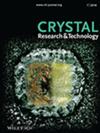射频溅射功率对柔性电光用AZO薄膜的影响
IF 1.9
4区 材料科学
Q3 CRYSTALLOGRAPHY
引用次数: 4
摘要
在本研究中,采用溅射技术在掺杂铟氧化锡涂层的聚对苯二甲酸乙二醇酯衬底上以不同的射频(RF)功率制备了Al (2.5 wt%)掺杂氧化锌(ZnO)的固定薄膜。X射线衍射(XRD)结果表明,所有薄膜都具有六边形结构的多晶性质。随着射频溅射功率的增加,薄膜的应力从−0.10 × 109 N m−2增加到0.23 × 109 N m−2。通过场电子显微镜观察,所有样品的形貌均为不规则球体。在130、140、150和160 W的射频溅射功率下生长的薄膜厚度的估计值分别为440、870、913和1086 nm。当射频功率从130 W增加到160 W时,光带隙从3.59 eV减小到3.48 eV。当溅射功率为160 W时,样品的最高电导率为2.43 × 102 S m−1。研究表明,溅射功率对在柔性衬底上生长的薄膜的各种性能有影响,这些薄膜在柔性电光应用中具有广泛的应用前景。本文章由计算机程序翻译,如有差异,请以英文原文为准。
Impact of RF Sputtering Power on AZO Thin Films for Flexible Electro‐Optical Applications
In the present work, fixed Al (2.5 wt%) doped zinc oxide (ZnO) thin films are fabricated at different radio frequency (RF) power on indium doped tin oxide‐coated polyethylene terephthalate substrate by sputtering techniques. From the X‐ray diffraction (XRD) results it has been observed that all thin films have polycrystalline nature with hexagonal structure. Stress of thin film calculated from XRD measurement is increased from −0.10 × 109 to 0.23 × 109 N m−2 with increase in RF sputtering power. The morphology analyzed by field electron microscopy is observed as irregular sphere for all samples. The estimated values of thickness are 440, 870, 913, and 1086 nm for the films grown at RF sputtering powers 130, 140, 150, and 160 W, respectively. On increasing the RF power from 130 to 160 W, the optical bandgap is decreased from 3.59 to 3.48 eV. The highest conductivity obtained is 2.43 × 102 S m−1 for the sample grown at sputtering power 160 W. The study reveals that there is an impact of sputtering power on the various properties of thin films grown on flexible substrates and these films have wide applications in flexible electro‐optical applications.
求助全文
通过发布文献求助,成功后即可免费获取论文全文。
去求助
来源期刊
自引率
6.70%
发文量
121
审稿时长
1.9 months
期刊介绍:
The journal Crystal Research and Technology is a pure online Journal (since 2012).
Crystal Research and Technology is an international journal examining all aspects of research within experimental, industrial, and theoretical crystallography. The journal covers the relevant aspects of
-crystal growth techniques and phenomena (including bulk growth, thin films)
-modern crystalline materials (e.g. smart materials, nanocrystals, quasicrystals, liquid crystals)
-industrial crystallisation
-application of crystals in materials science, electronics, data storage, and optics
-experimental, simulation and theoretical studies of the structural properties of crystals
-crystallographic computing

 求助内容:
求助内容: 应助结果提醒方式:
应助结果提醒方式:


